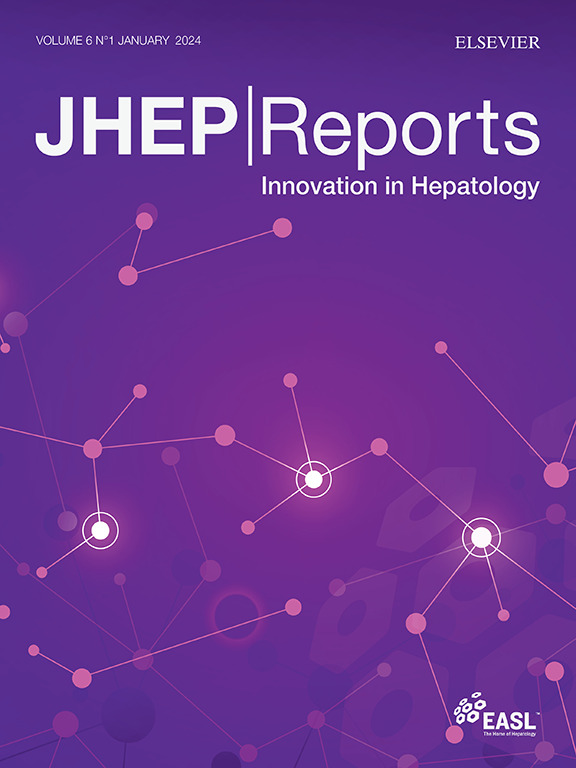SBRT for bridging and downstaging HCC before transplant
IF 7.5
1区 医学
Q1 GASTROENTEROLOGY & HEPATOLOGY
引用次数: 0
Abstract
Background & Aims
Stereotactic body radiotherapy (SBRT) has emerged as a bridging/downstaging therapy for patients with hepatocellular carcinoma (HCC) awaiting liver transplantation (LT). This study evaluates the safety and outcomes of the use of SBRT in such patients.
Methods
A retrospective review was conducted from 2004 to 2019 on 88 adult patients with HCC receiving SBRT as bridging/downstaging therapy. Endpoints, included treatment-related toxicities, liver function decline, and LT probability post SBRT, were analyzed using competing risk analysis.
Results
SBRT was used for bridging in 58 (66%) patients and downstaging in 30 (34%). Most patients had compensated liver function pre-SBRT and were treated with a median SBRT dose of 36 Gy in six fractions. Toxicities were mild (58% grade 1, 2% grade 2, and no grade 3 toxicities). Of the patients, 23% experienced a decline in liver function within 6 months post SBRT. The probability of LT post SBRT was 30% at 6 months, 61% at 1 year, and 73% at 2 years. Key predictors of LT post SBRT included model for end-stage liver disease (MELD) score, alpha-fetoprotein (AFP) level, and number and total tumor volume of HCC lesions. Overall, 61 (69%) patients underwent LT at a median of 6.3 months (IQR: 3.1–10.0) post SBRT, with major complications reported in 26% and an in-hospital mortality of 3%. Overall and recurrence-free survival at 1, 3, and 5 years post transplant were 88%, 83%, and 83% and 83%, 75%, 73%, respectively. The cumulative incidence of recurrence was significantly higher in the downstaging group compared with the bridging group (15%, 23%, and 32% vs. 7%, 15%, and 17% at 1, 3, and 5 years, respectively). Explant pathology revealed a 25% complete pathological response rate (bridging, 30%; downstaging, 12%).
Conclusions
Our results showed that SBRT is a safe and effective bridging therapy for HCC. However, its role in downstaging is limited by lower response rates and higher recurrence, emphasizing the importance of patient selection.
Impact and implications
SBRT is an emerging therapy for patients with HCC awaiting LT, with limited data available on its safety and efficacy. Our study provides crucial insights for physicians and researchers, demonstrating that SBRT is a safe and effective option for bridging patients with HCC to transplantation. These findings are important for optimizing treatment strategies and providing patients with additional therapeutic options while awaiting transplantation. However, the lower response rates and higher recurrence in the downstaging group highlight the need for further research to improve patient selection and tailor treatments for optimal outcomes.

移植前SBRT用于桥接和降低肝癌分期
背景,立体定向体放疗(SBRT)已成为肝细胞癌(HCC)等待肝移植(LT)患者的一种桥接/降期治疗方法。本研究评估了在此类患者中使用SBRT的安全性和结果。方法回顾性分析2004年至2019年88例接受SBRT作为桥接/降期治疗的成年HCC患者。终点包括治疗相关的毒性、肝功能下降和SBRT后的LT概率,使用竞争风险分析进行分析。结果58例(66%)患者接受了ssbrt治疗,30例(34%)患者接受了降期治疗。大多数患者在SBRT前肝功能得到了代偿,并接受了6次SBRT治疗,中位剂量为36 Gy。毒性较轻(58%为1级,2%为2级,无3级毒性)。23%的患者在SBRT后6个月内出现肝功能下降。SBRT术后6个月发生LT的概率为30%,1年为61%,2年为73%。SBRT后LT的关键预测因子包括终末期肝病模型(MELD)评分、甲胎蛋白(AFP)水平、HCC病变数量和肿瘤总体积。总体而言,61例(69%)患者在SBRT后中位6.3个月(IQR: 3.1-10.0)接受了肝移植,26%的患者报告了主要并发症,住院死亡率为3%。移植后1年、3年和5年的总生存率和无复发生存率分别为88%、83%、83%和83%、75%、73%。与桥接组相比,降分期组的累积复发率明显更高(1年、3年和5年分别为15%、23%和32% vs 7%、15%和17%)。外植体病理显示25%的完全病理缓解率(桥接,30%;,争取降期可射频消融(12%)。结论SBRT是一种安全有效的肝细胞癌桥接治疗方法。然而,它在降分期中的作用受到低有效率和高复发率的限制,强调了患者选择的重要性。ssbrt是等待肝移植的HCC患者的一种新兴治疗方法,其安全性和有效性的数据有限。我们的研究为医生和研究人员提供了重要的见解,证明SBRT是HCC患者桥接移植的安全有效的选择。这些发现对于优化治疗策略和为等待移植的患者提供额外的治疗选择非常重要。然而,低分期组的低有效率和高复发率突出了进一步研究的必要性,以改进患者选择和定制治疗以获得最佳结果。
本文章由计算机程序翻译,如有差异,请以英文原文为准。
求助全文
约1分钟内获得全文
求助全文
来源期刊

JHEP Reports
GASTROENTEROLOGY & HEPATOLOGY-
CiteScore
12.40
自引率
2.40%
发文量
161
审稿时长
36 days
期刊介绍:
JHEP Reports is an open access journal that is affiliated with the European Association for the Study of the Liver (EASL). It serves as a companion journal to the highly respected Journal of Hepatology.
The primary objective of JHEP Reports is to publish original papers and reviews that contribute to the advancement of knowledge in the field of liver diseases. The journal covers a wide range of topics, including basic, translational, and clinical research. It also focuses on global issues in hepatology, with particular emphasis on areas such as clinical trials, novel diagnostics, precision medicine and therapeutics, cancer research, cellular and molecular studies, artificial intelligence, microbiome research, epidemiology, and cutting-edge technologies.
In summary, JHEP Reports is dedicated to promoting scientific discoveries and innovations in liver diseases through the publication of high-quality research papers and reviews covering various aspects of hepatology.
 求助内容:
求助内容: 应助结果提醒方式:
应助结果提醒方式:


